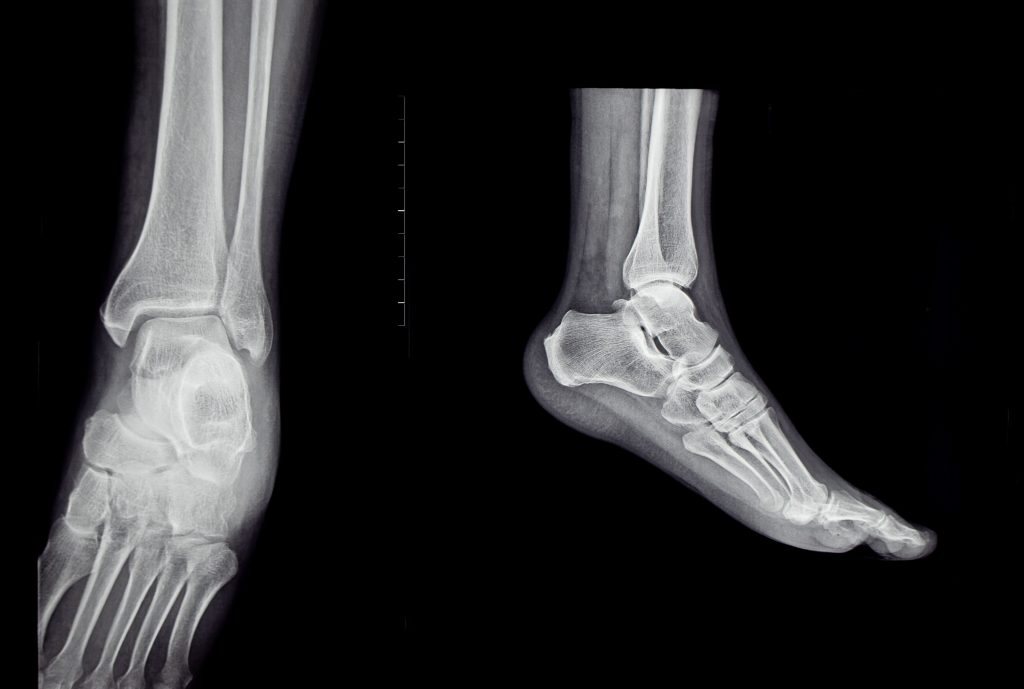What is ankle replacement surgery?
Ankle replacement is a surgical procedure used to treat ankle arthritis by removing and replacing damaged bone and cartilage in the joint with prosthetic implants. The prosthetic implant used in total ankle replacement consists of three parts: a titanium component attached to the tibia, a cobalt-chrome piece connected to the talus, and a polyethylene (plastic) implant placed between them. Ankle replacement relieves arthritis pain and maintains joint movement.

Why the Procedure Is Performed?
If the ankle joint is severely damaged, this surgical procedure may be necessary. Symptomatology often includes pain and limited range of motion in the ankle. Various factors can contribute to this kind of damage.
- Arthritis resulting from previous ankle injuries or surgical procedures.
- Bone fracture
- Infection
- Osteoarthritis
- Osteonecrosis
- Rheumatoid arthritis
- Tumor
If you had previous ankle joint infections, you may not be eligible for a complete ankle replacement.
What could be the reason for needing ankle replacement surgery?
If you are experiencing severe arthritis in your ankle, it may be reasonable to consider undergoing ankle replacement surgery. This condition can cause various symptoms such as intense pain, inflammation, and stiffness, resulting in challenges with walking. The main categories of ankle arthritis include:
- Osteoarthritis, known as degenerative joint disease, is a type of arthritis that occurs in the elderly as a result of the wear and tear on the joints.
- Rheumatoid arthritis is a condition that impacts the joints and is caused by an autoimmune response throughout the body.
- Arthritis can occur as a result of a previous joint injury.
If your arthritis is only mild or moderate, your healthcare provider will likely suggest alternative treatments such as pain medication, specialized shoe inserts, physical therapy, or corticosteroid injections. However, if your symptoms are severe and significantly affect your everyday tasks, your healthcare provider may suggest ankle replacement surgery or another surgical procedure.
What steps should I take to get ready for total ankle arthroplasty?
Having realistic expectations is crucial when it comes to undergoing surgery and rehabilitation. It is advisable to communicate with your care team to learn how to properly prepare for the procedure. Being aware of what lies ahead can assist you in getting ready for any difficulties and arranging for your recovery. Prior to the surgery, the team may suggest the following recommendations:
- Start physical therapy.
- Stop smoking.
- Stop taking certain medications.
Have a conversation with your family and friends about what the healing process will involve. It is likely that you will face difficulty in walking following the surgery to replace your ankle. It is important to create a plan to ensure that you can continue to perform daily activities. This may include seeking assistance with tasks such as grocery shopping, navigating stairs, or looking after a pet.

Ankle replacement surgery
Ankle replacement surgery can be done using general anesthesia or nerve block. To control bleeding and have a better view of the surgery, the surgeon will use a tourniquet. The approach to the ankle will vary based on the type of implant chosen. The surgeon will cut the bone and install metal and plastic components to recreate the ankle joint. In some cases, other procedures may be necessary to correct any deformities and properly align the foot and ankle. The surgeon will then close the incisions with stitches or staples and provide a splint for support.
What is ankle replacement recovery like?
The time it takes for patients to recover can differ, but here are the usual time frames and milestones.
The first four weeks
- Right after the operation, a cast is applied to the ankle, and you are prohibited from putting any pressure on the foot.
- During the initial two weeks, the ankle will be kept raised above the heart in order to reduce swelling and promote faster healing of the incision. Approximately 90% of the time, your ankle will be elevated, but you can still use crutches to move around for meals and restroom breaks.
- Once two weeks have passed, the stitches from the cut will be taken out, and your ankle will be placed in a boot that can be taken off. You will receive instructions for a workout routine to do at home, and at this point, you can remove the boot while showering, sleeping, and doing your exercises. However, it is still important to keep your leg elevated for 60% of the time.
Starting physical therapy after a duration of four weeks.
- Physical therapy can commence and weight can be gradually applied to the leg, with the aid of a protective boot, after the passage of four weeks.
- After eight weeks of surgery, it is permissible to discontinue wearing the protective boot and instead, use a normal shoe or sneaker for walking purposes.
Progress benchmarks for recovery after four months and beyond

- After four months, your condition will have improved compared to how it was before the surgery.
- By the time six months have passed, you can expect to have made approximately 75% progress in your recovery.
- One year after the surgery, you will have achieved the maximum improvement possible following the ankle replacement.
What are the risks of ankle replacement surgery?
In the majority of cases, ankle replacement surgery yields positive outcomes; however, it is not without certain risks. Some of these risks comprise:
- Infection
- Damage to nearby nerves
- Bleeding
- Blood clot
- The bones not joining together properly
- Misalignment of the bones
- New arthritis in neighboring joints
- The artificial components may become loose over time and potentially require additional surgery.
- Wearing out of the components
Complications you might experience can differ based on factors such as your age and existing medical conditions.
How long is it before you can walk after an ankle replacement?
The average patient can begin walking with a special boot four weeks after surgery, and they can switch to a regular shoe after eight weeks. However, if there is any additional foot surgery done during the ankle replacement procedure, it may take six weeks to start walking with a boot and ten weeks to be able to wear a normal shoe. The complete recovery timeline will be explained in further detail.
Treatment in Türkiye:
The medical staff of surgical teams, doctors, and consultants at REHABTÜRK can provide the best treatment options and free consultations, striving to stay up-to-date on the latest medical technologies and methods.
